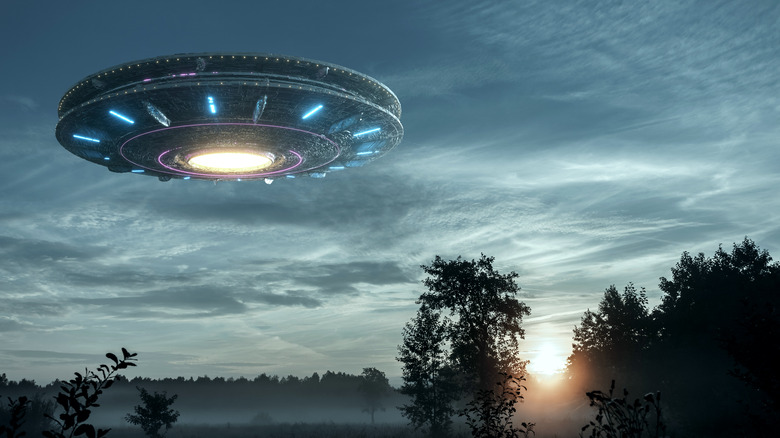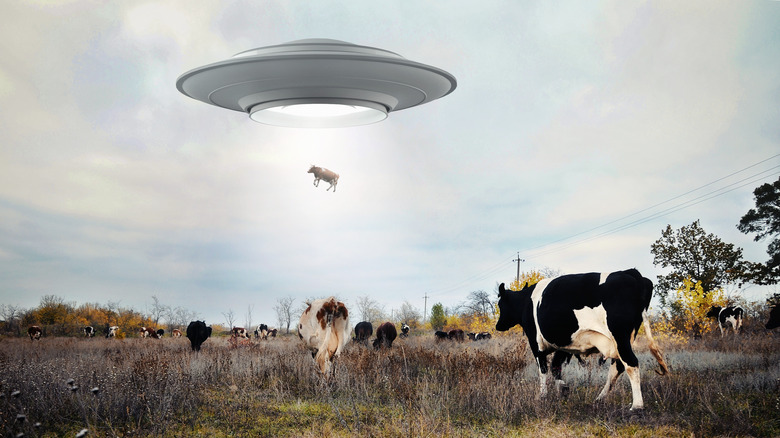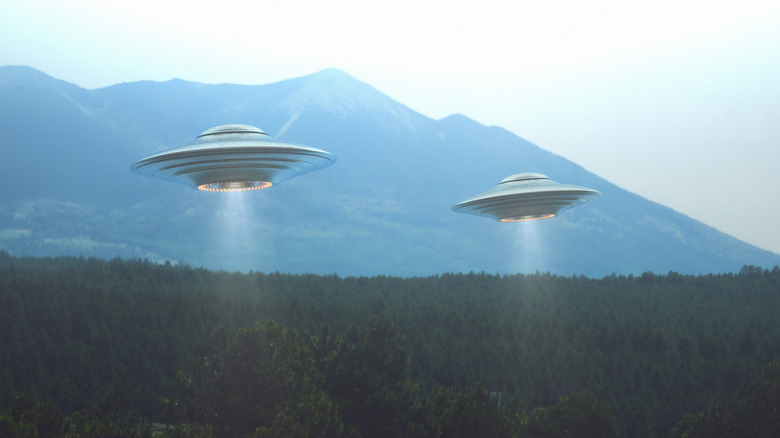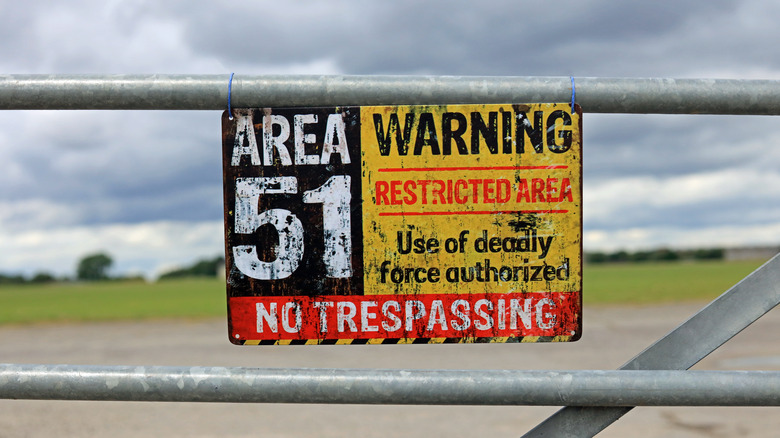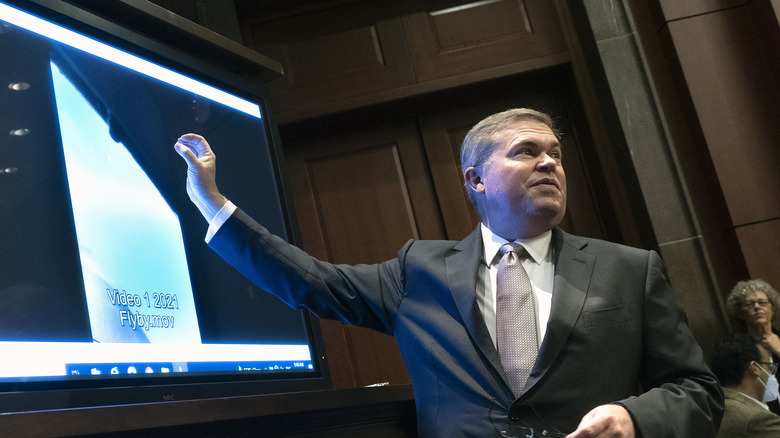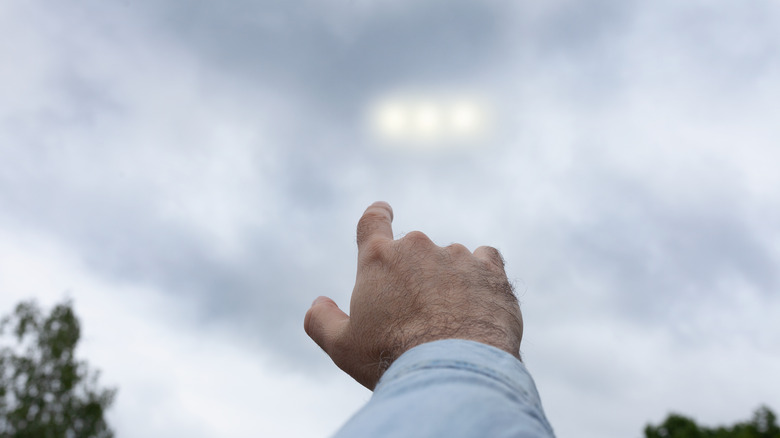The All-Domain Anomaly Resolution Office Explained
One of the longest-running, most popular conspiracy theories is that the United States government is somehow involved in UFO research. Now, that conspiracy theory is coming true — kind of. On July 20, the Department of Defense announced in a press release that they were reworking the existing Airborne Object Identification and Management Group, or AOIMSG, into the All-domain Anomaly Resolution Office, or AARO.
According to the press release, the AARO will "synchronize efforts across the Department of Defense, and with other U.S. federal departments and agencies, to detect, identify and attribute objects of interest in, on or near military installations, operating areas, training areas, special use airspace and other areas of interest, and, as necessary, to mitigate any associated threats to safety of operations and national security. This includes anomalous, unidentified space, airborne, submerged and transmedium objects" — transmedium referring to craft that can operate on land, air, and water.
It might sound like a lot of bureaucratic mumbo-jumbo, but what it boils down to is rather simple. The Department of Defense will be investigating UFOs.
What are UFOs?
Before you get too excited, keep in mind that UFOs, aka unidentified flying objects, aren't necessarily aliens, according to Metro. They can also be man-made items whose technology or form is unfamiliar to viewers. For example, advanced spyware created by a foreign government could be mistaken as alien technology by inexperienced viewers. For that reason, UFO sightings aren't just of interest to those hoping to meet an alien race; they're also a very real concern for Department of Defense officials.
The idea that there might be life on other planets has been discussed for hundreds of years. The first reports of unidentified flying objects began in the 1800s, according to PBS, and the phenomenon took off in the 1940s when there was increased government interest in what were then called "flying saucers." It wasn't until the early 1950s that the term UFO was coined to describe unidentified flying objects, with the rationale that the term's broad scope made it more accurate and broadly applicable than "flying saucers," according to Lexico.
The history of UFO sightings in the US
One of the most famous early UFO cases happened to a man named Kenneth Arnold in 1947, according to PBS. A pilot, Arnold spotted a strange set of nine objects flying in formation. He told a reporter they moved "like a saucer would if you skipped it across water." The phenomenon attracted a lot of public attention for the phenomenon of UFOs.
Later in 1947, the wreckage of what might have been a flying object was found in Roswell, New Mexico in what's now known as the Roswell UFO incident, according to History. After at first saying it was a weather balloon, decades after the incident, the U.S. government revealed that the whole situation was the result of an atomic espionage project. But by then, it was far too late to do damage control, as the incident had already become very well-known as a notorious close alien encounter. More UFOs were spotted throughout the 1950s and 1960s, according to History, including some that would spawn conspiracy theories about Area 51.
The obsession with Area 51
Though the U.S. government never had a designated UFO identification effort at Area 51, many people believe they did, in part because of alien research rumors that the U.S. government promoted, according to Vox. A military base, Area 51 is located in a remote region of Nevada. It was originally created by President Eisenhower to develop and test top-secret surveillance technology. For instance, the famous U-2 spy plane and the SR-71 Blackbird both came out of Area 51, as well as the F-117 Nighthawk and A-12, according to Britannica.
When people started to wonder if the facility was looking into UFOs and aliens, the CIA decided to foster that belief in order to hide the actual secret purpose of the base, Vox reports. Despite how well-known the name "Area 51" is now, it actually wasn't until 2013 that the government went on the record saying the military base exists, according to Britannica.
The All-domain Anomaly Resolution Office's mission
Now that there is an office dedicated to UFO research, what will that office do? The group will be directed by Dr. Sean M. Kirkpatrick, who previously worked at the Defense Intelligence Agency Missile and Space Intelligence Center, according to the Department of Defense press release. The AARO will work with the Air Force, Navy, and Army, Metro reports.
Though the AARO was officially established this year, the broader effort to address UFOs dates back to 2020, when a Senate committee decided the phenomenon needed to be looked into, according to Live Science.
Later, a 2021 report noted that greater investment by government agencies was required to investigate and address the rising numbers of UFO sightings in the United States, according to Vice. In fact, of nearly 150 UFOs seen by military planes, only one could be identified by government officials, reports NBC News, which concerned government officials for national security reasons.
What the AARO will look into
The AARO will investigate all UFOs, including "transmedium" UFOs, sometimes referred to as unidentified aerial phenomena, or UAP, as reported by Vice. According to the press release announcing the new department, the AARO's work will focus on surveillance, collection and reporting; system capabilities and design; intelligence operations and analysis; mitigation and defeat; governance; and science and technology, in that order.
A spokesperson for the Pentagon, Sue Gough, told Newsweek that they would seriously investigate all cases of UFOs seen in U.S. airspace. "Safety of our personnel and security of our operations are of paramount concern. We have always been concerned that incursions by unidentified aerial or anomalous phenomena could potentially pose a threat to U.S. national security," she said.
The AARO office has also recently established its own Twitter, where they said would be sharing "our examinations of unidentified anomalous phenomena across space, air, and maritime domains." They also posted, "This is an exciting and intellectually stimulating opportunity for us here at AARO."
